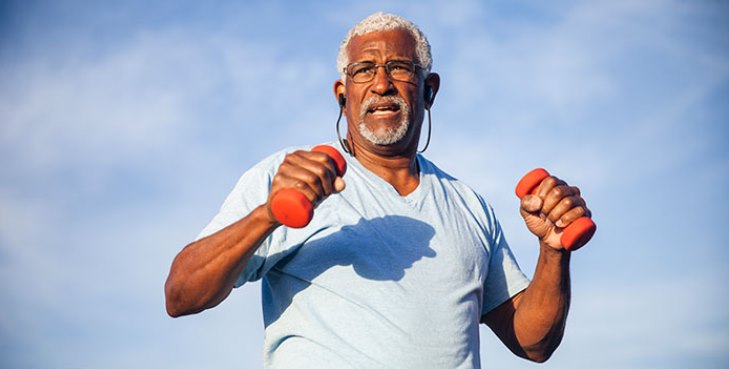You’re at the gym, doing a bench press. You push up, raising the barbell—that’s the “concentric” phrase. Now you ease the weight down toward your chest—that’s what exercise physiologists call the “eccentric” phase.
(That’s pronounced “ee-centric.” Not “eck-centric,” like a millionaire who wears old, rumpled clothes and leaves all his worldly possessions to his cats.)

Dr. Michael Harris-Love
VA’s Dr. Michael Harris-Love is a believer in the benefits of this particular form of physical exertion—eccentric exercise, aka negative work training. Google the term and you’ll find lots of sites devoted to elite athletes with chiseled physiques and bulging muscles.
But Harris-Love, with the Washington, D.C. VA Medical Center and George Washington University, is developing and testing programs that make specific use of eccentric training to help Veterans and others with a range of ailments and health challenges—including the frail elderly.
One health problem in his crosshairs is sarcopenia: the gradual drop in muscle mass, strength and function that comes with aging. Strength training and good nutrition can help prevent sarcopenia. Harris-Love asserts that eccentric training may be just what the doctor ordered when it comes to stopping or slowing the condition.
Eccentric strength training: More bang for the buck
“We want to look at muscle health in a way that is less costly, more efficient and more comprehensive.”
The investigator, who was a weightlifter himself before going on to become an exercise physiologist, physical therapist and health science researcher, explains that eccentric training can offer more bang for the buck: It can work the muscles with less stress on the heart, compared with conventional strength training.
“What’s interesting about lengthening contractions — during the eccentric phase of an exercise, the muscles lengthen — is that they place lower metabolic demands on the body. They use less oxygen for the same amount of energy. You tend to be 20 to 35 percent stronger eccentrically than concentrically, and there’s less cardiovascular demand. So for some infirm populations, light eccentrics might be useful because it’s less demanding on the heart.”
Harris-Love’s team is now looking at data from a study they did with people who had knee arthritis. “It’s a paradox,” he says. “Eccentrics has this reputation of huge muscle forces, and there are some risks for athletes for who may train this way. But here was this [older] population that was able to do it lightly and get some benefit out of it, despite having some physical limitations.”
To learn more about the study, visit VA Research Currents.
Topics in this story
More Stories
Study underscores important role COVID vaccination can have in protecting Veterans from infection and reducing long-term health consequences
Columbia VA’s robotic surgery teams completed their 800th robotic surgery and are on schedule to hit 1,000 by the end of the year.
In a decentralized clinical trial, Veterans can participate from their own homes or local VA instead of having to travel to a research site.







I’m 94…feel like I’m maybe 80. Have cancer, taking treatments, I live alone, take care of my home to the extent that there are no petitions to get me out of the neighborhood:) . Along with a good microwave I cook good meals I am widowed and want live in my home. I will need some help in the future on the care of the home and some house hold chores. Bathing is done very carefully in the shower on plastic bench. I wear a full time catheter and the taking a bath is sort of humorous in the preparation and all.. I want to get some good advice on this and how to apply.for some features that will keep me in the home. I am 60 % disabled. Own me home.
I’m thinking that physical therapy (exercise) will be a very wise and in the future some household assistance.
WW II Pilot-Corsica and Italy Korean Conflict Pilot Arctic Air Rescue